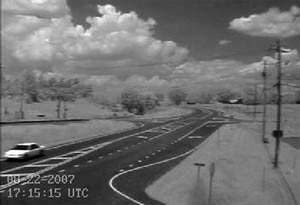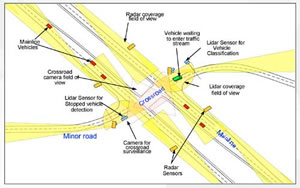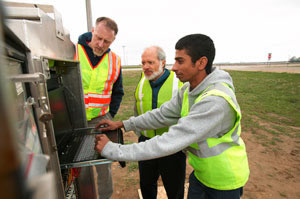Heading_1-RtCol
Paragraph Nibh euismod tincidunt; ut laoreet dolore magna aliquam erat volutpat ut wisi enim. Quinta decima eodem modo typi qui nunc nobis videntur parum clari fiant sollemnes.

Rural highway and intersection safety

Rural roadways make up only a small portion of the road network, but they are strongly over-represented in crash and fatality statistics. Since 2002, the IV Lab has worked to make rural through-stop highway intersections safer by developing systems that help drivers avoid crashes. The work begun at a single Minnesota intersection expanded to other states through a federal pooled-fund research project, and then was incorporated into the USDOT’s Cooperative Intersection Collision Avoidance System research initiative.
More information on CICAS-SSA and Intersection Decision Support is available on the Intelligent Transportation Systems Institute Web site.
CICAS-SSA

In 2007, the Minnesota Department of Transportation and the ITS Institute were selected by the U.S. Department of Transportation to participate in the Cooperative Intersection Collision Avoidance System–Stop Sign Assist (CICAS-SSA) research initiative.
The USDOT describes CICAS as a “cooperative” system, meaning it integrates data from both vehicle-based and infrastructure-based sensing systems via the newly allocated Dedicated Short-Range Communications portion of the radio spectrum. Warning display systems using this data are to be developed for both in-vehicle and outside-the-vehicle placement.
Minnesota’s CICAS research focuses on infrastructure-based solutions and includes five main components:
- A microscopic, in-vehicle measurement of driver gap acceptance at an instrumented intersection.
- Alert and warning algorithms to be used to appropriately inform drivers in a timely fashion of dangerous conditions.
- A deployable sensor system used both to compute the dynamic “state” of the intersection and to feed data required for triggering the alert and warning algorithms.
- A field validation and subsequent field operational test to quantify the performance and safety benefits of such systems.
- Wireless communications between the vehicle and the roadside equipment.
Intersection Decision Support

Understanding what causes crashes at rural through-stop highway intersections is a challenge for researchers. Incident reports filed by law enforcement agencies after a crash generally do not provide the level of detail necessary to reconstruct a crash, and there are few eyewitnesses in rural areas. In order to collect objective, high-resolution data on vehicle dynamics, the IV Lab research team designed a sensor network capable of tracking vehicles precisely as they approach an isolated rural intersection, as well as capturing the movements of vehicles entering or crossing the highway on video, 24 hours a day.
Data and images collected by this system enabled the research team to determine how different types of vehicles—ranging from small cars to large commercial trucks—performed turning and merging maneuvers. The system also recorded, for the first time, video of crashes and near misses at a rural through-stop intersection.
IDS research accomplished several important research goals that will contribute to CICAS research, including:
- Designing and implementing traffic sensor networks
- Developing an advanced vehicle trajectory measurement and recording system
- Studying driver gap acceptance behavior on a microscopic level using traffic simulation
- Testing new active displays in a driving simulator to determine what information a driver needs to safely maneuver through rural unsignalized intersections



